AdministrationRecycle! Lake CharlesOrdinance EnforcementSolid WasteStreet and Drainage MaintenanceStreetlights & Right-of-WayTraffic & CommunicationTransitWastewaterWaterMaintenanceEngineeringGrounds MaintenanceDrainage
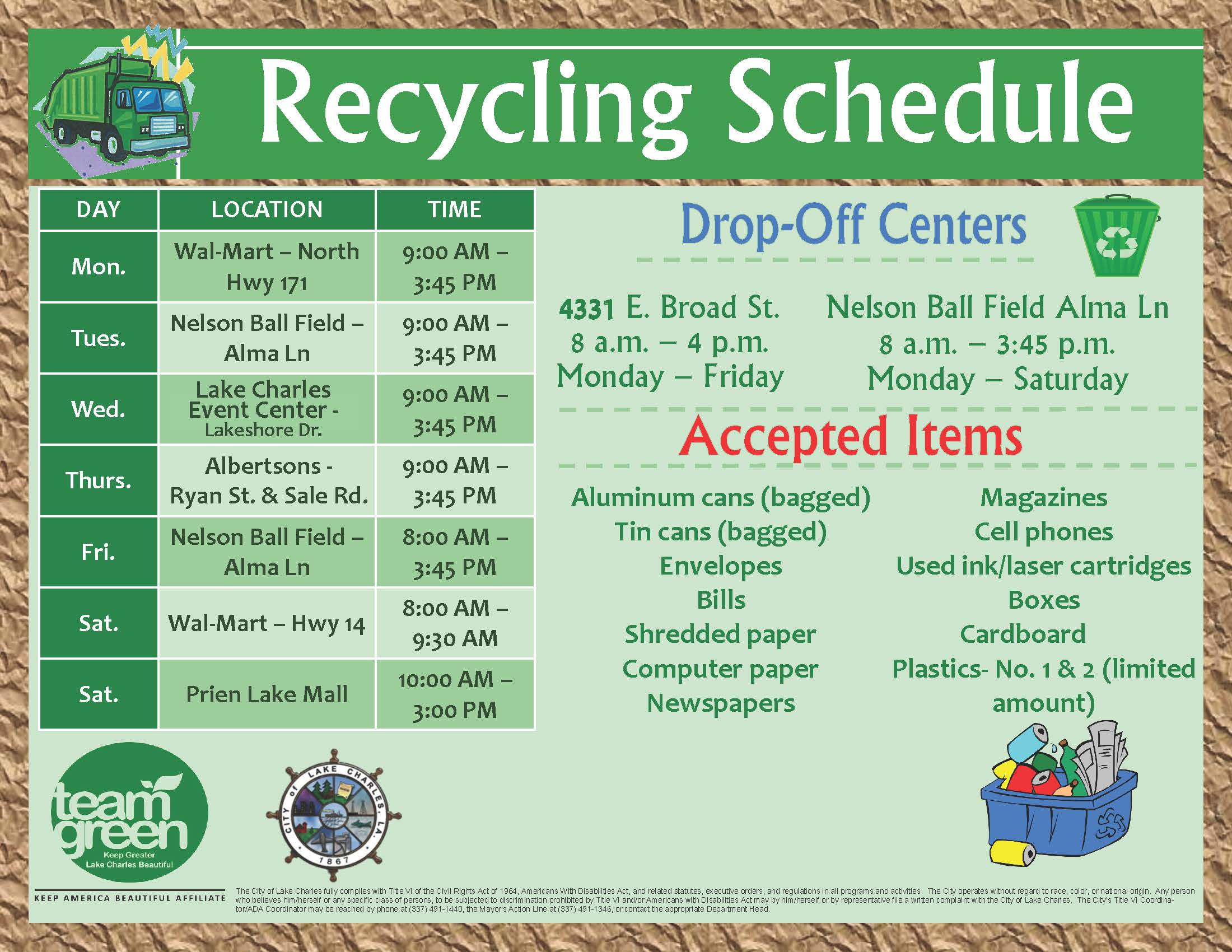
Some concerns are low hanging limbs over the street, neutral grounds, sidewalks and right-of-ways. Low hanging limbs from trees on private property or neutral grounds abutting private property are the responsibility of the property owner to maintain.
Other areas of concerns are blind corners or obstructions. Blind corners and obstructions can be from hedges, bushes and/or portable signs.
Garbage can concerns are received and investigated to ensure residents remove their cans from the curb on the same day of collection.
Storm Water ordinance is enforced through the Public Works Department and concerns include the blowing or discharging grass and leaves into the street.
Illegal signs placed on neutral grounds, right-of-ways and utility poles are enforced through the Public Works Department and a fine can be issued to the responsible parties if not removed after notification is received. Illegal signs can include businesses, garage sales, lost and found animals, or any advertisement signs posted on utility poles, between sidewalks and streets, or on any public property.
The Solid Waste Division of the Public Works Department provides garbage and trash collection and wood waste processing services for the City of Lake Charles. Garbage and non-burnable items collected from residences are taken to the Jeff Davis Landfill or the Waste Management Transfer Station. Burnable items are incinerated at the Wood Waste Processing Facility.
Solid Waste Division Responsibilities
- Furnish once-a-week garbage container collection.
- Provide container maintenance and repair on all city-supplied-and-owned containers.
- Provide collection of trash and yard waste from residences a minimum of two times per month.
- Provide a citywide collection of white goods from residences when required. All white goods must be free from all perishable food items. They must have the doors/lids removed or taped shut for public safety.
- Operate a wood waste processing facility for the general public.
Curbside Pick Up Information:
What is eligible for collection?
White goods
White goods are considered to be any household appliances including stoves, washing machines, dryers, window air conditioners, freezers and refrigerators. White goods must be totally separated from other MSW to allow for separate collection. Commercial businesses that deliver and install new appliances are required to remove the old appliances from the premise and insure proper disposal. The Clean Air Act prohibits knowingly venting ozone-depleting refrigerants (ex. Freon) while servicing or disposing of air conditioning/refrigeration equipment. Examples of equipment are refrigerators, freezers, and air conditioners, including automobile air conditioners and other equipment that contains refrigerants. In order for the City to remove these items, the refrigerant must be removed.
Building materials
The following items will be considered to be building materials; soil, metal, metal fencing, roofing material, sheetrock, ceiling tiles, floor tiles, paneling, carpet, plaster, concrete or other substances that may accumulate as a result of new construction, a demolition, common repairs, remodeling, building operations, or as a result of clearing lots. The owner shall have such items removed at their own expense
Tree and shrubbery trimmings
Waste accumulation of tree branches, tree limbs, parts of trees, bushes, shrubbery, cuttings or clippings, or other waste usually created as refuse in the case of trees or bushes. Tree limbs are not to exceed four feet in length and four inches in diameter.
Yard waste
It shall include cuttings of grass and weeds, fallen leaves, branches and vines, trees or limbs in any form which have been cut in lengths which can be easily handled and picked up, and do not exceed four feet in length or exceed four inches in diameter and weigh less than 50 pounds. All fallen leaves and to the maximum extent possible, small limbs and vines shall be placed in plastic bags. Yard waste must be totally separated from other MSW to allow for separate collection. Any limbs not conforming to the required length and diameter requirements will not be collected by the city. Trees and debris as a result of initial clearing of lots or as a result of building operations shall not be collected by the city. The owner shall have such items removed at his own expense.
What is ineligible for curbside collection?
Sec. 9-14. Items not to be collected.
- White goods that contain refrigerants will not be picked up by the City. The Clean Air Act prohibits knowingly venting ozone-depleting refrigerants (ex. Freon) while servicing or disposing of air conditioning/refrigeration equipment. Examples of equipment are refrigerators, freezers, and air conditioners, including other equipment that contains refrigerants In order for the City to remove these items, the refrigerant must be removed.
- The following items will be considered to be building materials: fencing material, roofing material, sheetrock, ceiling tiles, floor tiles, paneling, paint, carpet, plaster, concrete or other substances that may accumulate as a result of new construction, a demolition, common repairs, remodeling, building operations, or as a result of clearing lots.
- The owner must have all aforementioned items removed at their expense.
(Ord. No. 9709, § 1, 10-12-92)
Sec. 9-15. Yard waste commercially cut.
Every nursery man, tree surgeon, and every person who cuts or trims trees, or shrubs as an independent contract shall remove or cause to be removed all yard waste from the premises serviced by him and it shall be unlawful for such persons to deposit any tree, tree or shrub cuttings or trimmings at any location for collection by the city.
(Ord. No. 9709, § 1, 10-12-92)
Sec. 9-16. - Illegal piles
- Illegal pile defined. An illegal pile shall be any unauthorized accumulation of garbage or trash, litter, refuse, rubbish, appliances, building/construction debris or material, tires, limbs, trees, paint, or other discarded materials or debris or yard waste unlawfully placed on the curb side, neutral grounds, or premises, this includes vacant lots, when chapter 9, chapter 10, or any other provision, of the city’s Code of Ordinance requires such accumulation to be disposed of by the owner and/or prohibits its collection by the department of public works.
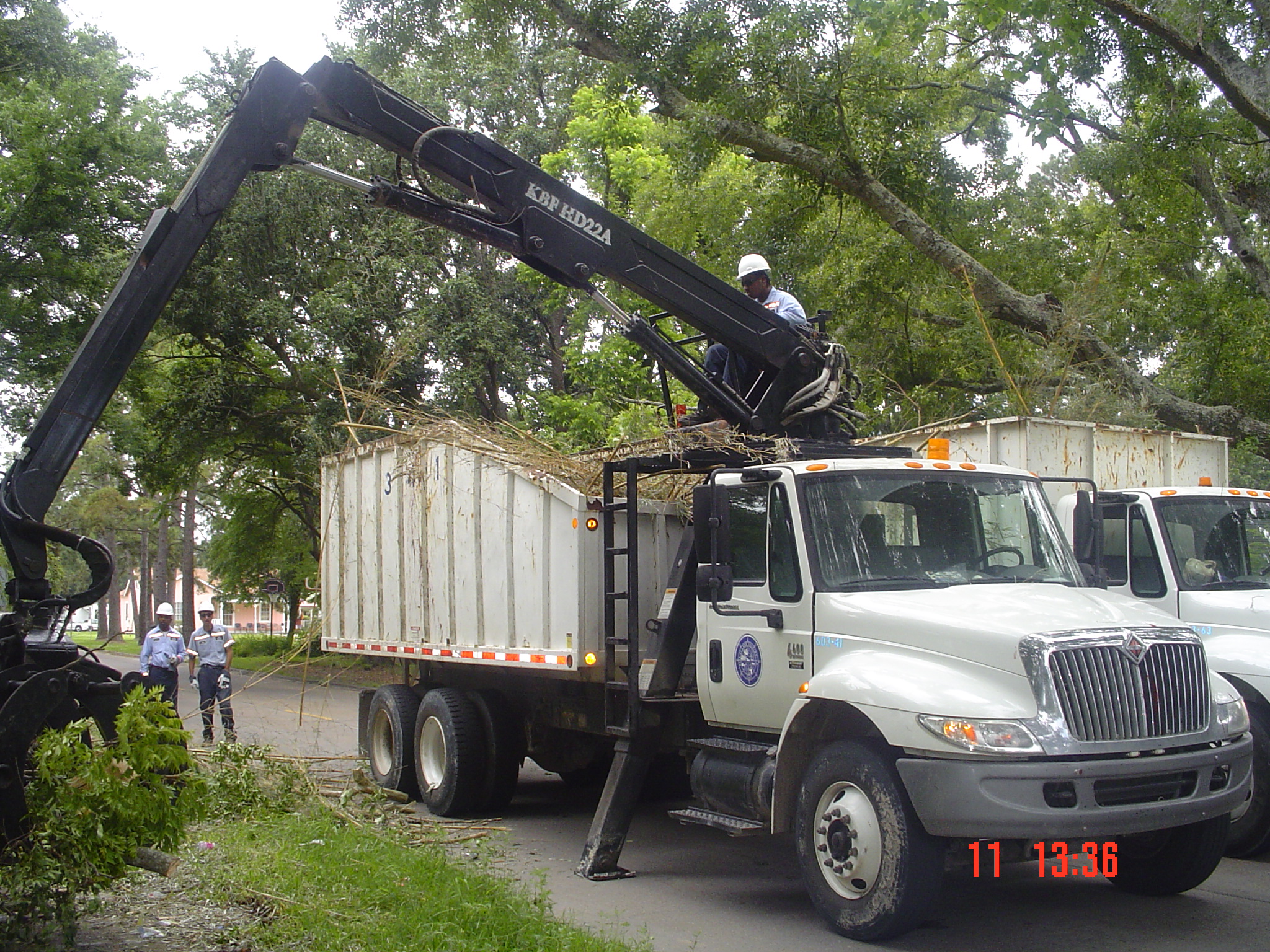
Call the Public Works Department Helpline at (337) 491-1220 or send an email to publicworks@cityoflc.us.
Entergy repairs all City streetlights except for ornamental lights in the downtown area and lights on the Enterprise and Shattuck Street overpasses. Outages should be reported to Entergy by calling 1-800-9OUTAGE or by using this link here to submit a report online. Outages can also be reported to Entergy via their mobile app.
When will the light be repaired?
If you feel your request is not being handled properly or need to report outages that Entergy does not repair, please contact the Public Works Helpline during regular business hours at (337) 491- 1220 or send an email to publicworks@cityoflc.us.
Who trims tree limbs around streetlights?
If the tree is on private property, it is the responsibility of the property owner to have the tree trimmed. Entergy does not trim tree limbs that interfere with streetlights.
Who trims limbs around electrical lines?
Entergy will trim tree limbs that jeopardize service lines along the street. Entergy does not trim trees that jeopardize service lines from the street to a home. That is the homeowner's responsibility.
Click here for more information on Entergy's tree trimming policy.
My street is dark. How do I get a streetlight installed?
Subdivision developers install streetlights at their expense. The City does not install streetlights in subdivisions, however, streetlights may be installed in older areas of town that are not part of a dedicated subdivision. The standard light spacing for streetlights is currently 180-200 feet.
Streetlights are installed for the benefit of vehicular and pedestrian traffic. Homeowners wanting security lights installed can contact Entergy at 1-800-ENTERGY. The cost of the security light is the responsibility of the homeowner.
The Communication & Traffic Division is responsible for the installation, programming, operation and maintenance of all traffic signs and signals within the City and also the installation and maintenance of radios in all City vehicles.
Communications for the City of Lake Charles is provided by a state-of-the-art radio system. The system has been operational since 1989 and has been expanded and updated over the years to make use of changing technologies as new options and features become available.
This division maintains all emergency vehicle lighting, sirens and all related equipment for all City departments.
Traffic Signals:
1. Who maintains traffic signals within the City of Lake Charles?
Maintenance of traffic signals on city streets is done solely by the Communication & Traffic Division of Public Works. Traffic signals on state routes are maintained jointly by city and state crews. However, the programming of state signals is the function of the State Department of Transportation and Development.
2. What is a traffic signal?
A traffic control signal is a type of highway signal by which traffic is alternately directed to stop and permitted to proceed. Traffic signals are described as either pre-timed or traffic-actuated. Under pre-timed control, duration of the red, green and amber intervals are predetermined. Under traffic-actuated control, the duration of green intervals varies according to traffic demands.
3. What are some advantages of traffic signals?
Traffic control signals, properly located and operated, usually have one or more of the following advantages:
(a.) They provide for the orderly movement of traffic.
(b.) Where properly used, they can increase the traffic handling capacity of an intersection.
(c.) They can reduce the frequency of certain types of accidents, especially the right-angle type.
(d.) Under favorable conditions, they can be coordinated to provide for continuous or nearly continuous movement of traffic at a definite speed along a given route.
(e.) They can be used to interrupt heavy traffic at intervals and/or to permit other traffic (vehicular or pedestrian) to cross.
4. What are some disadvantages of traffic signals?
(a.) Many people believe that traffic signals provide the solution to all traffic problems at intersections. This has led to their installation at a large number of locations where no legitimate need exists.
(b.) Excessive delay may be caused.
(c.) Disobedience or disregard of the traffic signal is encouraged.
(d.) The use of less adequate routes in an attempt to avoid such signals.
(e.) Accident frequency (especially rear-end type) can be significantly increased.
5. Preventive maintenance program
Our signal preventive maintenance consist of inspecting each and every signal within the City every 18 months. At this time we clean and service the signal heads and replace any parts needed and service the signal controller and cabinet. Records are kept of all work done and are on file by intersection.
6. Responding to emergency signal calls
The Public Works Department receives calls for signal malfunctions from various sources such as the Police Department, Fire Department, other City Departments and directly from citizens. A signal technician immediately responds to all calls for any reported signal malfunction. Repairs are made and the signal is put back into operation as soon as possible.
Calls for bulb outages are will be addressed right away or before the end of the work day; depending on the work schedule of the signal technician.
Records are kept of any and all work done on signals and are filed by intersection name and number.
7. Signal timing
This division, based on traffic volume and movement, determines timing for all city-operated signals. We are replacing some signal controllers with actuated-control as well as redesigning some intersections to meet the traffic demand.
8. Request for new signals at non-signalized intersections
Request for new traffic signals are routed through the Engineering Division of Public Works. If this request has merit then we are directed to do a study of the intersection for warrants as set forth in the MUTCD. This study may be cursory or in-depth depending on the warrants met. We then give Engineering our recommendations.
9. Records
Records in the form of work reports are kept on all work preformed on traffic signals and are filed by intersection name and number.
Signs:
1. How do I request a sign?
(a.) Stop and yield signs: Requesting a stop and/or yield sign at a new location requires City Council action to pass an ordinance. Contact the city councilperson for the area in question and make the request to them. You may call the Clerk of Council at (337) 491-1290 to find out the name and contact number for the area in question or give the information to the clerk.
(b.) Speed limit signs: Speed limit signs requests can be made directly to Public Works and require no council action, unless the request is to change the speed limit. In this case the procedure is the same as for stop and yield signs.
(c.) No parking signs: These also require City Council action unless it is to repair or replace an existing sign. Any questions, such as if parking is allowed or not at a particular location, may be directed to Public Works.
(d.) Other signs: All other sign requests, such as Watch for Children, School Signs, Pedestrian Signs, Side/Road Markers and Street Markers may be directed to Public Works.
2. How to report a missing or damaged sign?
Whenever you notice a damaged or missing sign, it may be reported to the City Police or directly to Public Works.
3. Why do we install various signs?
Stop signs: The stop sign causes a substantial inconvenience to motorists, it should be used only where warranted. A stop sign may be warranted at an intersection where one or more of the following conditions exist:
1. Intersection of a less important road with a main road where application of the normal right- of-way rule is unduly hazardous.
2. Streets entering a through highway or street.
3. Un-signalized intersection in a signalized area.
4. Other intersections where a combination of high speed, restricted view and serious accident record indicates a need for control by the stop sign
Prior to the use of stop signs, less restrictive measures such as yield signs, where a full stop is not necessary at all times, would be recommended.
Stop signs should never be used to control speeding!
The primary objective of the speed table program is the reduction of vehicle speeds on residential/subdivision streets. There may be certain beneficial side effects to speed table installations, such as a reduction in arterial traffic diverted to local streets, but the intended purpose is speed control.
To learn more about the City of Lake Charles Traffic Calming Program, click here.
Crosswalks:
1. Where are they required?
(a.) At high traffic intersections with pedestrian traffic
(b.) Near schools and playgrounds where pedestrian traffic is present
(c.) Anywhere that traffic and pedestrian movements conflict and a need for protected crossings are warranted by traffic studies
2. Where should crossings be located?
Crossings should always be located at a controlled intersection and mid-block
crossings should be discouraged.
3. How do I report a crosswalk in need of maintenance or request a new crosswalk?
Contact the Public Works Department.
|
|
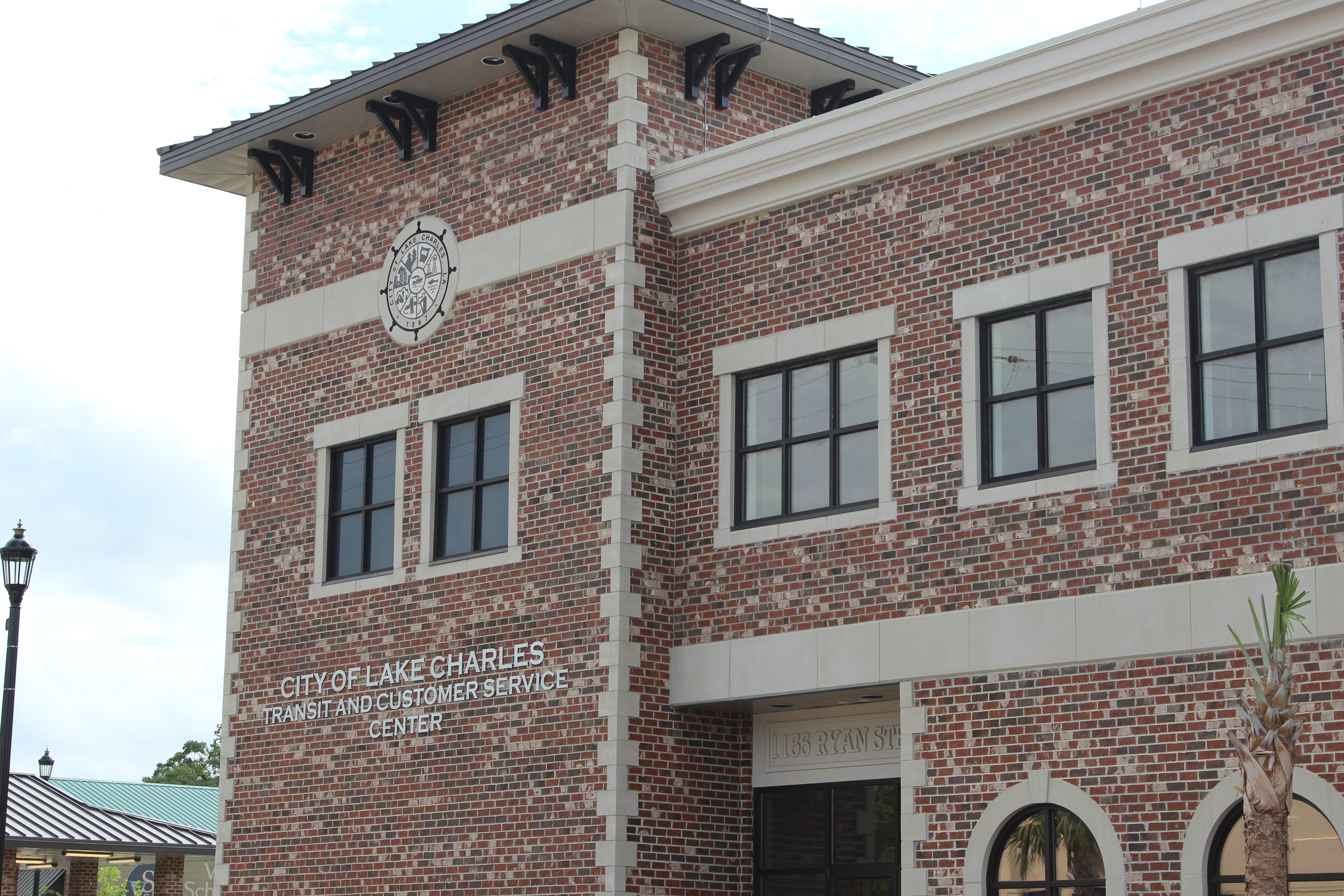
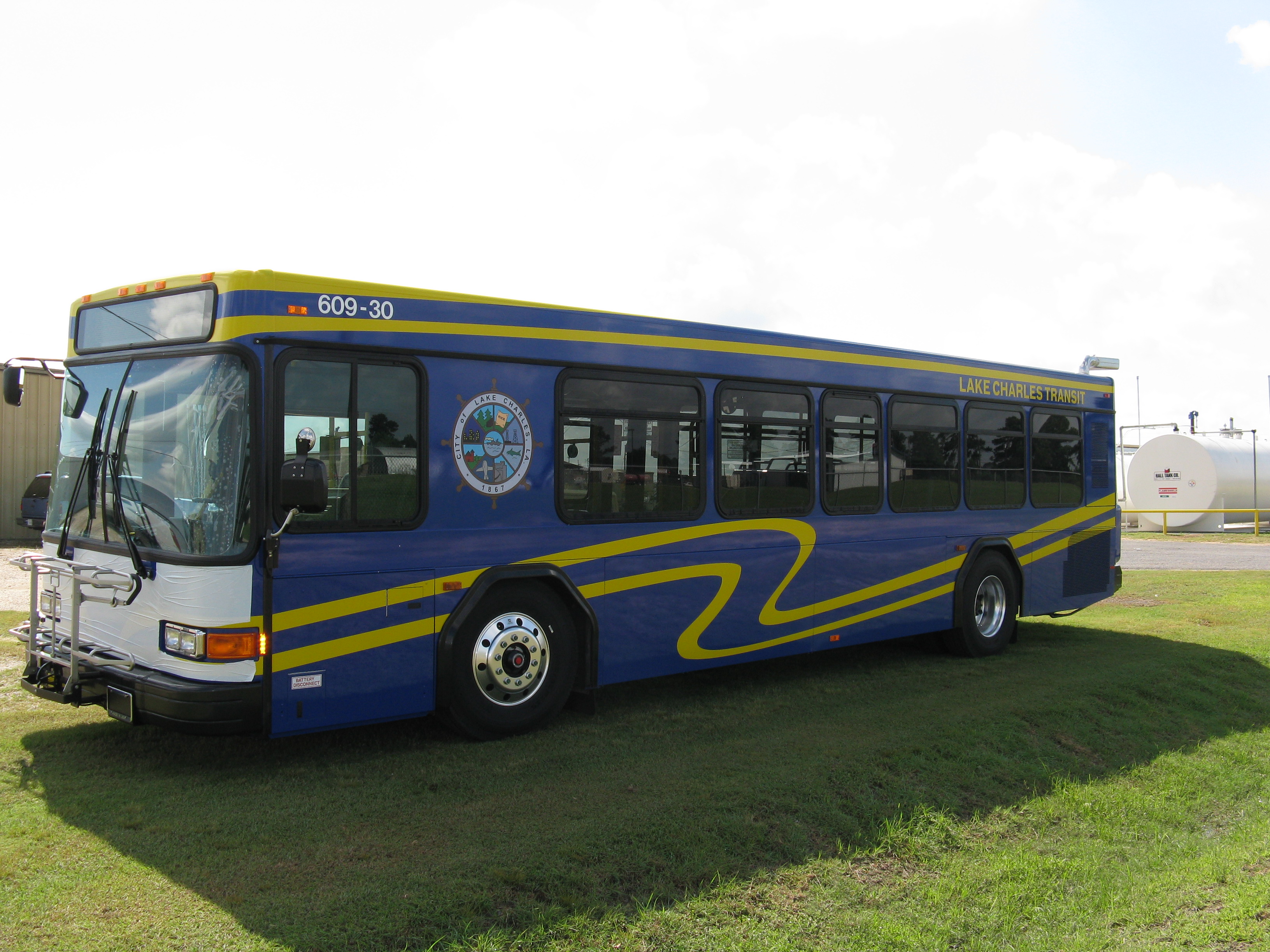
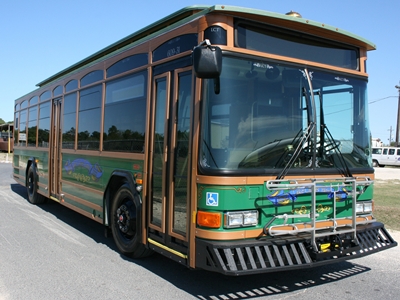
Regular fares apply for each passenger. Your bike rides for FREE!
Bus Fares
- Seniors: $0.50 (Persons age 65 or older. Must present current picture ID with birth date)
-
Disabled/Medicare/Medicaid: $0.25 (Must present current picture ID. Must present government issued ID with red disabled symbol. For Medicare/Medicaid discount, Medicare/Medicaid card must be presented.)
-
Student Rates $0.50 (Must present Student ID when boarding)
- Veterans: $0.25 (Must present a Veteran Picture ID when boarding)
All discount cards must be shown each time you board to ride at a discounted rate.
-
Transfers will be issued upon request when fare is paid.
-
Transfers are valid for one continuous trip.
-
Transfers are not valid for stopovers.
Please have exact change for fares as operators do not carry change. All fares are to be paid into the fare box upon boarding.
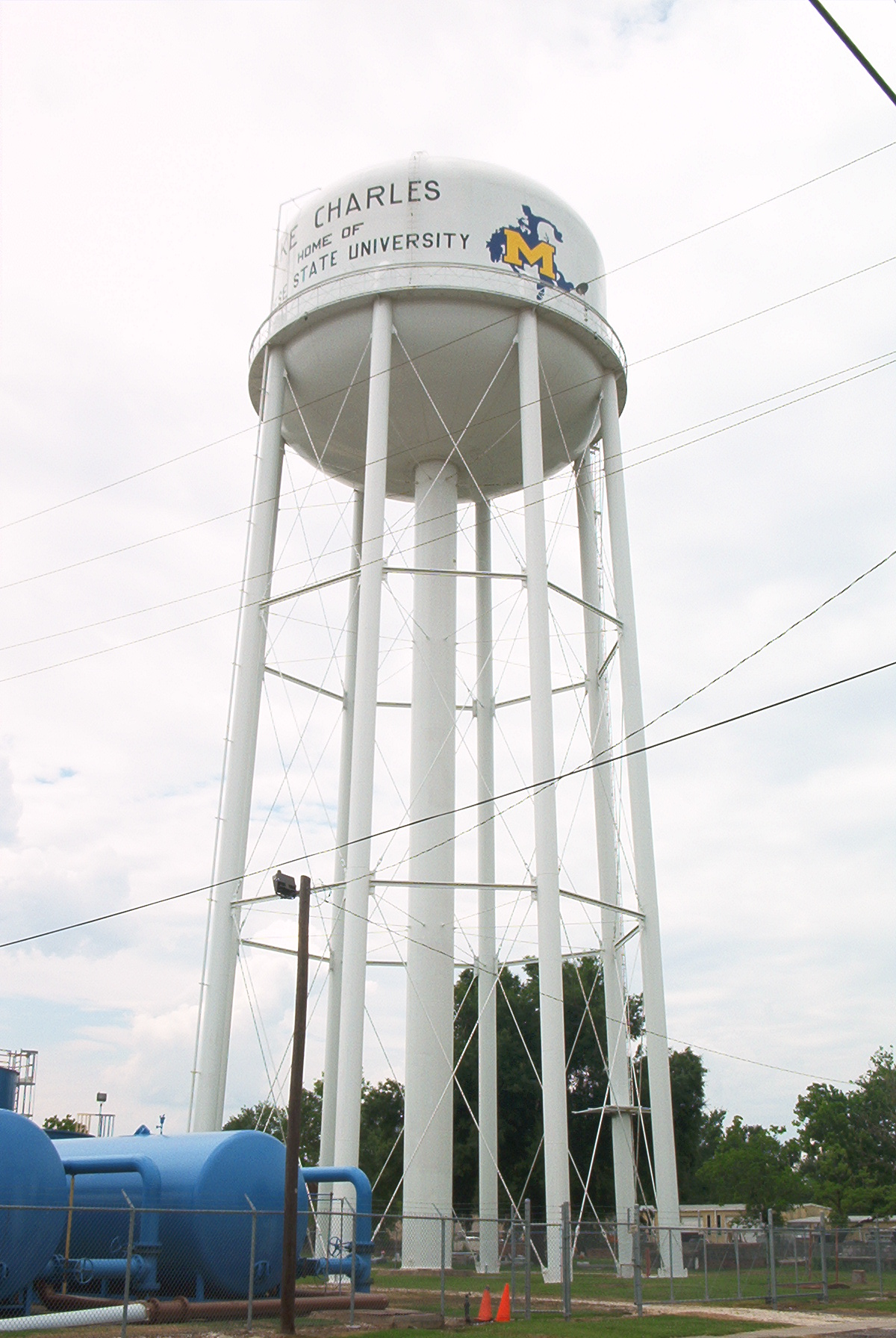
Lead Service Line Compliance Information
In compliance with the Louisiana Department of Health, the City of Lake Charles has completed the Lead Service line inventory for customers serviced by the Water Division. COLC used contractors to follow all State of Louisiana and Federal guidelines for determining the status of the water service Lines. A variety of methods such as actual visual inspection, construction plan reviews, statistical analysis, and historical knowledge were used for the determination.
City of Lake Charles is pleased to report that no specific instances of Lead Service lines were noted in the service limits of the municipality.
https://app.mapline.com/map/map_25bd6aeb/NXhBUHREdUNValdlb3VMNzlCL3J3RFBGN3paMHloVE56bGVXdG
Vehicle Maintenance Division
Tory Ceaser, Technical Superintendent
(337) 491-1420
Services include repairs and maintenance of all electrical, plumbing, mechanical and air conditioning systems within city-owned buildings. This division also offers services in carpentry, locksmith and painting while utilizing both in-house and outside services.
Drainage/Grounds/Beautification Maintenance
The Drainage/Grounds/Beatification Maintenance/Right-of-Way (ROW) Maintenance Division is responsible for maintaining City ROWs, boulevards, city-owned facilities, cemeteries and drainage systems. This drainage system includes underground drainage, surface drainage and open-ditch drainage.
Equipment and Crews
Equipment used for drainage/ground maintenance includes Grad-all and Vac-all. Grad-alls are used to clean ditches and Vac-alls blow and clean drains, catch basins and culverts.
Sweepers: This division has five street sweepers, one vacuum sweeper and three flat-bed dump trucks. The street sweepers clean the debris out of the gutter line of the streets to prevent debris from going into the City's drainage system. The flat-bed trucks dump the sweepers when they get loaded and haul the materials to the dump. Sweepers sweep four times at week for eight hours at day for a total of 160 hours a week, 640 hours a month and 7,685 hours per year.
Slope Mowers: These mowers are used to maintain the open ditches and City ROWs throughout the City of Lake Charles. They are used to cut high grass out of the ditches so water can drain properly. The City has three slope mowers. The slope mowers cut open ditches four days a week for a total of 32 hours a week, 128 hours a month and 1,536 hours per year.
Edger Tractor: The City has one edger tractor that is used to maintain and edge the City ROWs and medians throughout the City of Lake Charles.
Bush Hogs: This equipment is used to maintain City ROWs, natural ground and lots owned by the City throughout the City of Lake Charles. The City has two bush hogs, two flare mowers and one 15-inh wing deck bush hog.
Spray Truck: This truck is used to maintain the City's ditches and ROWs. The City has one spray truck. The City is also working with a new vendor who sprays our open ditches three times a year. The City of Lake Charles has a total of 52 miles of open ditches.
Bus Route: This division maintains the entire City-owned Bus Stop and Transit Facility. They pick up litter, weed eat, weed, treat for ant and conduct general cleaning.
Riding Mower: Riding mowers are used to maintain all City-owned facilities, boulevards, cemeteries and other locations given by supervisors. The division has a total of 12, 60-inch cut riding mowers and has recently purchased three propane mowers for better air control.
Drainage Repair: For drainage repair, the drainage crew uses a track hoe and a dozer. The track hoes are used to excavate damaged drain lines for repair and the dozers are used to level aggregate roadways and City-owned property.
Beautification Crew: This crew is responsible for maintaining all trees, flower beds and bushes at City-owned facilities, boulevards and other locations given by supervisors.
General Purpose Crew: This crew of four to five workers clean and weed eat city ditches and ROWs, pick up liter throughout the City and cut low-hanging limbs from trees over the street and sidewalk of City-owned property. They also clean up oil spills and respond to emergency calls.
In conjunction with the above-mentioned equipment, the drainage crew uses four dump trucks to haul debris when cleaning ditches and when performing other special jobs. These dump trucks also serve as the means to bring the track hoe and dozer to job sites.
The City of Lake Charles is divided into 10 zones and maintenance crews, using the sweepers, Grad all and the Vac-con, work their way through each zone, beginning with Zone 1. In each zone, they clean ditches, drains, catch basins, etc.
Repair crews, using the track hoe and the dozer, are dispatched to specific sites from calls taken through the Public Works Helpline. Citizens, councilmen, and other City departments/divisions call in problems and complaints to the Public Works Helpline. The Drainage/ Ground Maintenance Supervisor will investigate the complaints and after investigation, he will prioritize the calls based upon his findings, create work orders for them and place them on the work schedule.
Calls will come into the Helpline for problems that must be addressed by the maintenance crews using the Grad-all and Vac-alls. These work orders become part of the General Purpose, Sweepers, Slope Mowers, Bush Hogs, and Spray Trucks divisions.
Work Schedules
Drainage/Grounds Maintenance/ROW Maintenance Crews: This includes drainage crew, bus route crews, sweepers, slope mower, bush hog, spray truck, ground maintenance and beatification crews.
- Monday through Thursday- 6:45 a.m.-5:15 p.m.
ROW Crew:
- Monday through Thursday- 6:45 a.m.-5:15 p.m
General Purpose Crew:
- Monday through Friday- 6:45 a.m.-3:15 p.m.
Inmate Crew 1 - Litter Abatement:
- Monday thru Thursday - 8:00 a.m. - 4:30 p.m.
Inmate Crew 2 - Maintain City-owned Cemeteries:
- Monday through Thursday - 8:00 a.m.- 4:30 p.m.
Complaint Procedures
When citizens have complaints concerning drainage, they should call the Public Works Helpline at (337) 491-1220. These calls are processed by the employees who staff the Helpline. The information is placed into the Public Works work order system. When calls come in about emergencies such as "cave-ins," they are immediately dispatched via radio to the Drainage/Grounds Maintenance Division so that the area of the emergency can be barricaded. The location of the emergency is noted in the Drainage/Grounds/Beatification Maintenance Division's Barricade Report and is monitored daily by the Drainage Foreman and Drainage Supervisor.
The work order system is monitored by the Drainage/Grounds/Beatification Maintenance Division Supervisor and Foreman. Drainage calls usually are investigated by the Drainage/Grounds Maintenance/Supervisor on the following day. However, in certain instances, such as adverse weather conditions, large drainage jobs, emergencies, etc., the time of investigation may be delayed.
After the supervisor prioritizes the calls that come into the Helpline, he creates work orders for them. Once work orders are created, they can be placed into the drainage work schedule.
Drainage/Grounds/Beatification Maintenance crews operate on a two-week schedule. The two-week schedule can and will be interrupted when new calls come in that develop into high priority work orders. High priority work orders supersede regularly scheduled work.
For certain jobs, the crews will need to dig or disturb the ground in some way. When work of this nature is to be performed, the Drainage/Ground/Beatification Maintenance Division will call in a "Dottie" to the state of Louisiana. For "Dottie's" located in Calcasieu Parish, the state of Louisiana mandates a 48-hour waiting period from the time the "Dottie" has been called in to the time someone can start digging.
Once the "Dottie" has been marked, the crew can begin the work. Unless said crew has to respond to an emergency call, they will finish the job started.
Please note: Mayor's Action Line calls are also entered in the work order system and are handled in the same manner as calls that originate with the Help Line.
General Purpose Crew/ground Maintenance
Each day, crews work diligently, performing a variety of tasks. This work includes cutting grass at City-owned facilities, boulevards, cemeteries, and other locations given by supervisors; weed eating, edging sidewalks, collecting litter, cleaning and weed eating open ditches, barricading events as needed, cleaning oil spills, parade clean-up, trimming low-hanging tree limbs, removing obstructions from street signs and responding to call-outs created by citizen requests
Weed eating is done to improve the look of sidewalks, adjudicated lots, the underside of overpasses, and the pillars that support them. Often, weed eating is used to maintain neutral ground and fence lines on select streets.
Departing and Returning to Public Works Yard
Drainage/Ground Maintenance Division employees are to clock in by 6:45 a.m. Then a daily pre-trip inspection is performed on all equipment/vehicles that will be used for the day. The crews are to leave the Public Works Yard no later than 7:10 a.m. The crew does not return to yard until 4:45 p.m.
Upon arrival at the yard, the operators must do a post-trip inspection and also fuel equipment.
Employees then clock out at 5:15 p.m.
General Purpose Crew do not return to the yard until 2:45 p.m.
Upon arrival to the yard, the operators must do a post-trip inspection and also fuel equipment.
Employees then clock out at 3:15 p.m.
Related Pages
- Americans with Disabilities Act (ADA) Action Plan
- Annual Consumer Confidence Report - 2024
- West Sallier Reconstruction Renderings
- 2024 LC Launch Calendar of Events
- LC Create Contest Announced as part of LC Launch Small Business Week Events
- Enterprise Extension - Ent Goos
- Enterprise Ext - Fitzenreiter
- Enterprise Ext Goos Blvd
- Enterprise Extension Entire Project
Upcoming Events
- City Council Agenda MeetingDecember 30 5:30 pm - 11:59 pm
- City Council MeetingJanuary 07 5:30 pm - 11:59 pm
- City Council Agenda MeetingJanuary 13 5:30 pm - 11:59 pm
- City Council MeetingJanuary 21 5:30 pm - 11:59 pm
- City Council Agenda MeetingJanuary 27 5:30 pm - 11:59 pm
Contact Us
Director of Public Works
- Phone: (337) 491-1220
- Fax:
(337) 491-9187 - Staff Directory
- Hours: Monday - Friday, 8:00 AM - 4:30 PM
